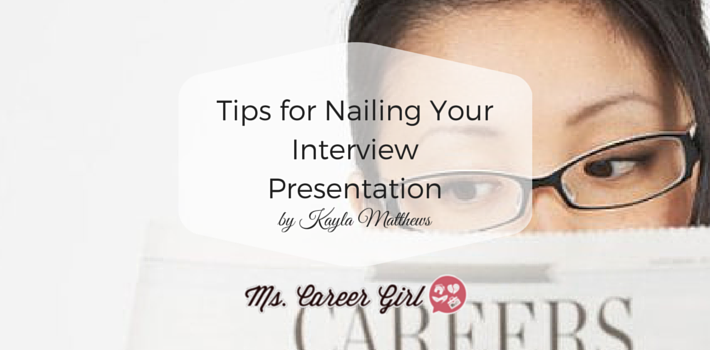Tips for Nailing Your Interview Presentation

Imagine the stress, nerves and anxiety associated with interviewing for a job — multiply that by 10, and that’s how you might initially feel when you’re told to perform an interview presentation.
You’ll have to speak in front of a group of professionals and show them why you’re the best candidate for the job. It looks like those public speaking classes are coming in handy for something, after all.
At this final stage in the interviewing process, it’s more important than ever to perform well. However, if public speaking isn’t your strong point or if you feel as though this is too stressful, relax. Preparing for an interview presentation is just like preparing for a regular interview. If you take the time to get ready, there’s no reason you shouldn’t nail it.
Have Structure
This presentation is supposed to show your qualifications, so you want it to be structured and organized. A good rule of thumb is to make it seem as though you’re telling a story. It’s much more engaging if it seems like a journey — where you started out, how you got your qualifications, what you plan to do with the job once you get there.
Cover the past, present and future. Most importantly, keep their attention. Start with an engaging beginning, move onto strong arguments and end with a compelling conclusion.
Incorporate Visual Aids (And Have a Backup Plan)
Hearing someone do nothing but talk for an entire presentation is tedious and will lose people’s attention instantly. It’s a smart idea to include visuals such as display boards for the benefit of the people in the room. But don’t let the visuals overwhelm your presentation.
Images and visuals are great tools — they can show your skills and your accomplishments, something that words alone cannot always do. If you’re relying on an electronic presentation, have a backup plan in case something isn’t working that day. The last thing you want to do is look unprepared.
Practice Beforehand
You should know your presentation inside out before you step into the room. Go through your presentation and make a note of any little thing that could be important, such as when to emphasize a point, when to pause, even when to breathe.
Ask some friends you trust to watch your presentation and act as the panel. Have them ask questions, particularly questions you think will be asked. Keep this up until you’re confident you know the presentation well.
Maintain Strong Body Language
The way you carry yourself says more than your words can. For example, if you pace back and forth, you appear nervous. When you stand firmly or move with a purpose, it shows you’re confident. When you’re presenting, show you’re confident and comfortable.
If you don’t think you can do that, fake it. Have those trusted friends of yours call you out when you’re slumping or closing yourself off. Be aware when you have weak body language and correct it until it’s second nature.
Know Your Audience
Remember, you’re essentially selling your brand to potential employers. Show them why they should invest in it. You should know who will be there, what the company does, the culture — anything that will work in your favor. Just as you tailor your resume or cover letter for each job you apply to, you need to make sure this presentation is a perfect fit for the people who will see it.
Wear Your Power Outfit
As crazy as it sounds, what you wear affects how you feel. When you think you look good, you feel good. Wear your best professional outfit — a nice pencil skirt with a blazer and modest heels or a rocking pantsuit with a sharp blouse — and make it your own. Don’t go too crazy with the accessories, but if you need a flash of color add a necklace or a bracelet.
Getting ready for the interview presentation can be stressful and nerve-wracking, but with practice and a bit of psychological boosters, you’ll walk in that room knowing you’re ready for it.
Images by Kaboompics and Unsplash

